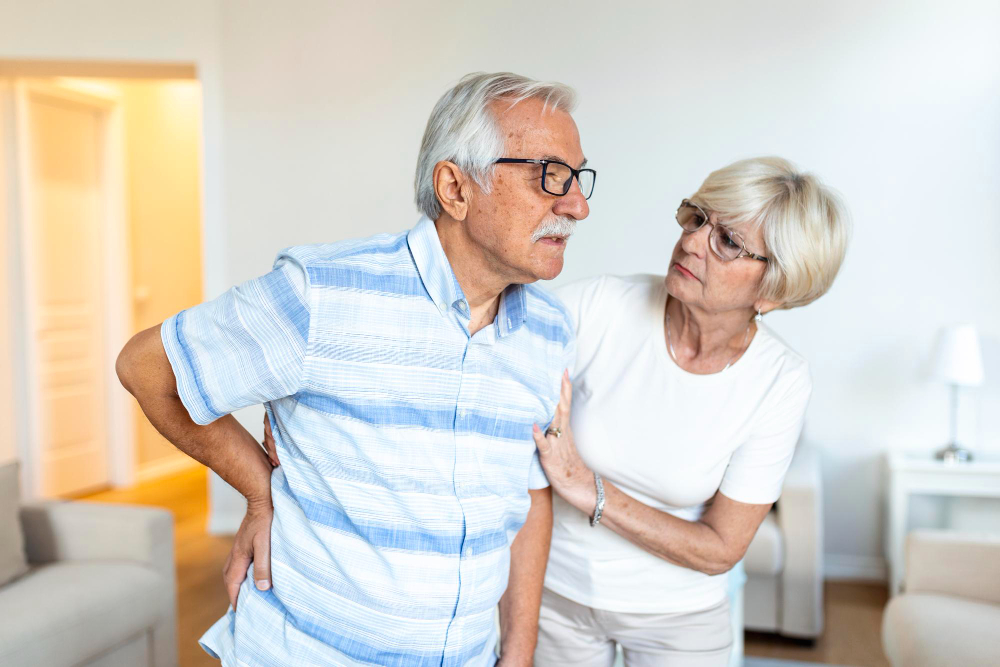Essential Exercises for Spine, Joints, and Overall Mobility

Essential Exercises for Spine, Joints, and Overall Mobility Facebook Twitter Youtube Instagram Pain in the back, neck, joints, or heels can significantly affect daily life, limiting mobility and independence. The good news is that targeted exercises and simple lifestyle habits can strengthen muscles, improve flexibility, and prevent injuries. At MJ Naidu Hospitals, we believe in empowering patients with knowledge and exercises that support long-term musculoskeletal health. These are the easy-to-follow exercises for the cervical spine, shoulders, hips, knees, ankles, coccyx, and heels, along with tips to prevent back pain. These routines are designed to enhance mobility, reduce pain, and keep you active at any age. 1. Cervical Exercises (Neck Exercises) Maintaining neck flexibility and strength helps prevent stiffness and reduces the risk of cervical pain. Key exercises include: Neck rotations and tilts Chin tucks Shoulder blade squeezes Benefits: Improves posture Reduces neck tension Prevents headaches caused by muscular strain. 2. Shoulder Exercises Strong and flexible shoulders support arm movements and upper body strength. Exercises may include: Arm circles and shoulder shrugs Resistance band stretches Wall push-ups Benefits: Reduces shoulder pain Enhances range of motion Prevents injuries from repetitive strain. 3. Spine and Back Exercises Healthy spine and back muscles are crucial to prevent chronic pain and maintain posture: Cat-cow stretches Bridges Lumbar rotations Tips to Prevent Back Pain: Maintain proper posture when sitting or standing Lift objects with knees, not the back Take short breaks to stretch if sitting for long periods 4. Hip Exercises Strong hips support walking, running, and balance. Recommended exercises include: Hip bridges Side leg raises Clamshells Benefits: Reduces hip pain Improves stability Prevents falls. 5. Knee Exercises Knee exercises strengthen muscles around the joint and improve mobility: Quadriceps sets Hamstring curls Straight leg raises Benefits: Supports knee function Prevents osteoarthritis progression No pain during daily activities. 6. Ankle and Foot Exercises Ankle strength and flexibility are important for balance and walking: Ankle circles and pumps Toe raises Heel-to-toe walking 7. Heel Pain Exercises: Calf stretches Plantar fascia stretches Towel scrunch exercises Benefits: Reduces heel pain Prevents plantar fasciitis Improves ankle stability. 8. Coccyx (Tailbone) Mobility Exercises: Coccyx mobility exercises help relieve tailbone pain, especially after prolonged sitting: Garland Pose (Malasana) Child’s Pose (Balasana) Cat-Cow Pose (Marjaryasana-Bitilasana) Benefits: Improves Flexibility Reduces Tailbone Discomfort Supports Pelvic Stability. 9. Tips for Overall Musculoskeletal Health Stay Active: Incorporate daily movement and gentle exercise. Maintain Proper Posture: Use ergonomic chairs and avoid slouching. Strengthen Core Muscles: Core stability supports spine, hips, and knees. Stretch Regularly: Keeps joints flexible and reduces stiffness. Seek Professional Guidance: Consult physiotherapists for personalized exercise plans. Regular exercise and proper body mechanics are the keys to pain-free movement and long-term joint health. By incorporating these cervical, shoulder, spine, hip, knee, ankle, and coccyx exercises, you can reduce pain, improve mobility, and maintain an active lifestyle. For personalized exercise plans and professional guidance, schedule a consultation with MJ Naidu Hospitals’ Orthopedics and Physiotherapy specialists. Our team will create a tailored program to keep you moving comfortably and prevent musculoskeletal issues before they start. Enquire now Table of Contents Cervical Exercises (Neck Exercises) Shoulder Exercises Spine and Back Exercises Hip Exercises Knee Exercises Ankle and Foot Exercises Heel Pain Exercises: Coccyx (Tailbone) Mobility Exercises: Tips for Overall Musculoskeletal Health MJNaidu hospital latest Updates delivered straight to your inbox Follow Us You have been successfully Subscribed! Ops! Something went wrong, please try again.
Boost Your Bone Health Naturally: Tips for Stronger Bones and Osteoporosis Prevention

Boost Your Bone Health Naturally Facebook Twitter Youtube Instagram Healthy bones are essential for staying active and living life to the fullest. Yet, many people think that taking calcium supplements alone is enough to maintain bone health. While calcium is vital, a combination of balanced nutrition, regular exercise, and healthy lifestyle habits plays a crucial role in keeping bones dense, strong, and resilient. Poor bone health can lead to conditions like osteoporosis, making bones fragile and more prone to fractures. This blog explores science-backed ways to boost your bone health naturally, helping you maintain strength and mobility at every stage of life. 1. Essential Nutrients for Strong Bones To maintain optimal bone density, your body needs several key nutrients: Calcium: The building block of bones, calcium is essential for bone strength. Include dairy products like milk, cheese, and yogurt, or plant-based sources like spinach, kale, and fortified almond or soy milk. Vitamin D: Helps your body absorb calcium efficiently. Sunlight exposure, fatty fish like salmon, and fortified foods are great sources. Magnesium: Supports bone structure and calcium regulation. Found in nuts, seeds, whole grains, and green leafy vegetables. Protein: Necessary for bone repair and maintenance. Include lean meats, fish, eggs, legumes, and dairy. Other Micronutrients: Vitamins K and C, phosphorus, and zinc contribute to bone strength and overall skeletal health. 2. Bone-Boosting Foods Adding the right foods to your daily diet can naturally improve bone density: Dairy Products: Milk, yogurt, and cheese provide calcium and protein. Leafy Greens: Spinach, kale, and broccoli supply calcium, magnesium, and vitamin K. Nuts and Seeds: Almonds, walnuts, chia seeds, and flaxseeds offer magnesium and healthy fats. Fatty Fish: Salmon, sardines, and mackerel are rich in calcium and vitamin D. Fortified Foods: Plant-based milks, cereals, and orange juice can help fill nutritional gaps. 3. Lifestyle Habits for Strong Bones Weight-Bearing Exercises: Walking, jogging, climbing stairs, dancing, and resistance training stimulate bone growth and increase density. Sun Exposure: 10–15 minutes of daily sunlight helps your body produce vitamin D naturally. Avoid Smoking and Excess Alcohol: Both habits weaken bones and increase fracture risk. Nutrition alone is not enough; lifestyle habits greatly influence bone health. Maintain a Healthy Weight: Being underweight or overweight can strain bones and joints. 4. Tips for Different Age Groups Bone health needs vary with age: Young Adults (20s–30s): Focus on building peak bone mass with balanced nutrition and regular exercise. Avoid smoking and limit caffeine. Middle Age (40s–50s): Maintain bone density with continued exercise and nutrient-rich foods. Consider bone density screenings if risk factors exist. Seniors (60+): Emphasize gentle resistance training, balance exercises to prevent falls, and routine monitoring for osteoporosis. 5. Preventive Measures Daily habits can help protect and strengthen bones naturally: Eat calcium- and vitamin D-rich foods at every meal. Engage in weight-bearing or resistance exercises 3–4 times per week. Limit processed foods, sugar, and excessive caffeine. Avoid smoking and reduce alcohol intake. Regularly monitor bone health with your doctor. Strong bones are key to an active and independent life. By combining proper nutrition, regular exercise, and healthy lifestyle habits, you can naturally maintain bone density and reduce the risk of osteoporosis. For personalized guidance on bone health, nutrition, and lifestyle plans, schedule a consultation with MJ Naidu Hospitals’ Orthopedics and Nutrition specialists. Our team can help you create a customized plan to strengthen your bones and maintain optimal skeletal health for years to come. Enquire now Table of Contents This blog explores science-backed Essential Nutrients for Strong Bones Bone-Boosting Foods Lifestyle Habits for Strong Bones Tips for Different Age Groups Preventive Measures MJNaidu hospital latest Updates delivered straight to your inbox Follow Us You have been successfully Subscribed! Ops! Something went wrong, please try again.
Joint Pain in the Elderly: Causes, Risks, Prevention, and Treatment

Joint Pain in the Elderly: Causes, Risks, Prevention, and Treatment Facebook Twitter Youtube Instagram As we age, joint pain becomes our regular companion, and not to forget that once it sets in, the damage can’t be undone, but can only be managed. Pain showing up as we age is common, but it can be delayed if we are vigilant and alert during our mid-years by choosing a healthy lifestyle and diet. According to the University of Michigan National Poll on Healthy Aging, 70% of adults over 50 experience joint pain at least occasionally, and 60% have been diagnosed with some form of arthritis. Nearly half of those with arthritis report daily pain (45%), and about 49% say joint pain limits their usual activities to some extent. Over a third (36%) find that it interferes with their daily life. Let’s uncover more about joint pain causes and how joint pain treatment works. You may not feel it until you fracture it: How to work around joint pain? Bone loss happens as we age, and certain conditions trigger it. For instance, in women, it speeds up after menopause. The tricky part is you don’t feel it happening; you are going about your day, and a sudden twitch, a snap, that’s it. Your bones are your supportive bestie, always holding you up, but sometimes your bestie can’t offer you all. That’s where the unchecked bone loss kicks in with signs. What is Arthritis and How is it Different from Osteoarthritis? While the terms ‘osteoarthritis’ (OA) and ‘arthritis’ are sometimes used interchangeably, they aren’t synonymous. Arthritis encompasses over 100 joint conditions characterized by inflammation, affecting both the joints and surrounding connective tissues. Osteoarthritis is a specific type of arthritis, often referred to as degenerative or wear-and-tear arthritis, because it results from long-term joint usage as people age. Osteoarthritis results from cartilage breakdown at the ends of bones where joints form, leading to pain and stiffness. It’s the most common form of arthritis, affecting 32.5 million adults in the United States, and is followed by rheumatoid arthritis (RA) an inflammatory type that can damage joints and organs. Globally, osteoarthritis is a leading cause of disability. Common Symptoms of Osteoarthritis Pain in affected joints, worse after activity or long days Stiffness, especially after rest or inactivity, improves with movement Tenderness and general discomfort Reduced range of motion and loss of flexibility Crepitus – grating, clicking, or popping sounds during joint movement Bone spurs – extra bone at joints, may form visible lumps Swelling in the tissues surrounding the joints as OA progresses Frequently Affected Joints Knees: Pain, difficulty walking, climbing stairs, getting in/out of bed Hips: Pain in the hip, groin, inner thigh, buttocks, or knees; reduced mobility Other areas: Shoulders, hands, fingers, feet Spine: Neck and lower back pain/stiffness Pressure on spinal nerves causing: Weakness Numbness Tingling in arms/legs Severe cases: bowel/bladder dysfunction Types of Joint Pain Wrist Joint Pain Wrist pain commonly arises from repetitive strain, sprains, or underlying conditions like carpal tunnel syndrome. It may gradually impact movement and fine motor control. Knee Joint Pain Often linked to overuse, injury, or degenerative issues like osteoarthritis, knee joint pain can affect mobility and stability in everyday activities. Finger Joint Pain Pain in the finger joints may be due to inflammatory diseases such as rheumatoid arthritis or gout. It causes stiffness, swelling, and difficulty with precise tasks. Hip Joint Pain Hip joint pain may result from age-related cartilage wear, bursitis, or muscle strain. It often limits motion and may spread to nearby areas like the thigh or groin. Hand Joint Pain Hand joint discomfort often stems from arthritis or repetitive use injuries. It can make gripping or performing routine tasks painful and difficult. Leg Joint Pain Leg joint pain may originate from issues in the hip, knee, or ankle, or be related to nerves. It can vary in intensity and often worsens with prolonged activity. What are the Notable Joint Pain Causes? Injury Joint damage can result from falls, sprains, overuse, or strain on tendons and ligaments. Common injury sites include the shoulder, knee, hip, wrist, and ankle. Osteoarthritis (OA) Caused by the gradual breakdown of cartilage due to aging or joint stress. More common in older adults, especially those with excess weight, prior joint injuries, or a genetic predisposition. Autoimmune Diseases Includes conditions like rheumatoid arthritis, psoriatic arthritis, and lupus, where the immune system mistakenly attacks joint tissues. Often begins in younger adults and disproportionately affects women. Gout (Crystalline Arthritis) Triggered by high uric acid levels, leading to sharp crystals forming in joints—most frequently the big toe. Often linked to dietary habits and genetic susceptibility. Pinched or Inflamed Nerve Occurs when nerves supplying the joint are compressed or irritated. Examples include carpal tunnel syndrome (wrist pain) and spinal nerve compression (hip pain). Joint Infection Though rare, infections spreading through the bloodstream can invade joints, causing sudden pain, swelling, redness, and systemic symptoms like fever or chills. Joint Pain Treatment A combination of lifestyle modifications and targeted therapies is apt for osteoarthritis. Guidelines for joint pain treatment highlight the importance of weight loss, regular exercise, and participation in self-management programs led by arthritis educators. Complementary approaches such as tai chi, yoga, cognitive behavioral therapy, acupuncture or acupressure, and the use of braces, splints, Kinesio taping, and topical treatments like heat, cold, or pain relievers are also encouraged. Despite these recommendations, while 64% of individuals with joint pain report engaging in exercise and 24% have undergone physical therapy, fewer utilize non-drug strategies such as braces. In terms of medication, the focus remains on short-term use of over-the-counter pain relievers at the lowest effective dose, alongside steroid joint injections for selected cases. As regards workout inclusion, it is advisable to add bone-strengthening exercises to your routine, like walking, resistance band workouts, or light weight training. A simple and consistent workout routine will do wonders. You might feel fine today, but that doesn’t always mean your joints are thriving. Osteoarthritis often whispers before it shouts. So, listen

